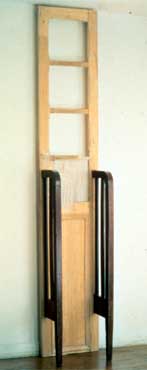 |
La
Casa Viuda IV, 1994
Wood, fabric and bones
257.5X46.5X33 cm
Courtesy Alexander and Bonin, New York |
MF:
As the new Editor of this magazine, I am very insistent
that ours is a humanistic project, that it isn’t
enough to expose and analyze only war crimes, violence,
and horror. It is imperative that we also explore the
creative discourses that are born as a response to brutality,
complicity, opportunism, and psychic and social sclerosis.
For me, your works and artistic process stand out for
all the right reasons: your absolute respect for the
individuals you interview, resistance in the face of
formally facile or narrative "solutions,"
and painstaking manual labor. These all come together
to form what I would call an ethical code.
DS: I would prefer not to talk in terms of an
ethical code in relation to my work, for in attempting
to confront inhumanity my position as an artist is precarious.
Primo Levi teaches us that each extreme experience imposes
extreme limits on the individuals who live through it—victims
as well as victimizers.
Absolute situations are very complex, and it is precisely
within that complexity that we find what it is to be
human. In bearing witness to inhumanity we learn to
recognize humanity.
My work is based on the testimonies of victims of violence,
on experiences that are alien to me. I am not a direct
witness, I am witness to the witness, a secondary witness.
I search for an intimate proximity with the victims
of violence that will permit me to stand in for them
as I actually make the work, but in such a way that
their experience takes precedence over my own.
MF: In all my years of interviewing Argentine
survivors of the Dirty War torture centers and relatives
of desaparecidos, I was constantly haunted by
the question: How can I justify my alien presence
in the midst of so much intimate pain?
DS: Exactly. You need to be there; the individual
impelled to testify needs you to be there. Yet there
is still this impossibility: I cannot speak for anyone
I interview. My work is driven by this need to try and
fail, over and over. Only during the actual process
of creation, as I struggle against the panic engendered
by the horror, does the overwhelming sensation of failure
temporarily recede.
MF: Yet your installations are so powerfully
articulate. They never give in to what might be called
`the tyranny of narrative,’ but their sense is
undeniable. For example, the piles of impaled starched
white shirts you did in 1989-90. Carefully folded in
columns of varying heights, the sheer number of shirts
speaks to the great number of killings; the immaculate,
ordered quality of this installation suggests bureaucracy,
orders handed down from on high.
DS: The victims have been forced to the edge
that separates what is human from is inhuman, they perceive
the world differently [from the rest of us], they feel
like strangers. [Franz] Rosenzweig says that the only
language appropriate to the tragic hero is silence,
and that every work that approaches tragedy must guard
this silence.
I present an image that is loaded with experience yet
silent, without anecdote, where the viewer, in an act
of silent contemplation, may bring his own memory of
pain into contact with that of the victim, and it is
from this juxtaposition that the meaning of the work
arises.
|
|


